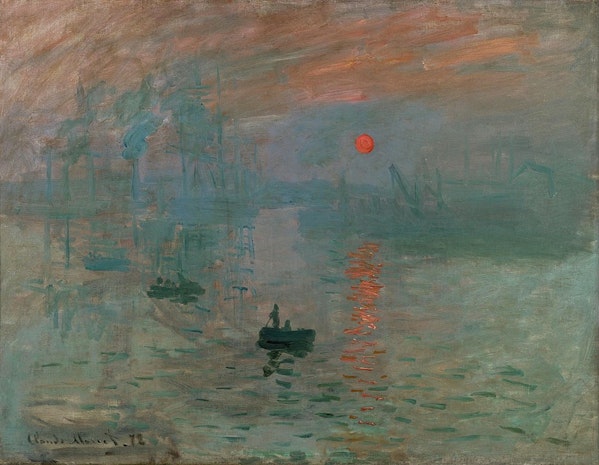
Claude Monet, Impression, soleil levant, 1872
Impressionism Impressionism, or Impressionism, is an artistic movement that emerged in France in the late 19th century. It originated from a group of painters who were active in Paris at the time.
Impressionist painters organized independent exhibitions in the 1870s and 1880s in opposition to the conservative French academy art exhibition, the Salon de Paris. The painters who participated in these exhibitions are generally referred to as Impressionists.
The name "Impressionism" is derived from the work of Claude Monet, the representative work of this artistic movement, 《 Impression, Sunrise Impression, Sunrise" by Claude Monet, a representative work of this artistic movement. The painting was praised by the critic Louis Leroy in the Paris satirical newspaper "Le Charivari".
The mural that is still to be painted looks more finished than the one that has not yet been painted. The painting was criticized by Louis Leroy in the Parisian satirical newspaper "Le Charivari," who said
This was the beginning of the term "Impressionism". What was initially a critical and pejorative designation became an art movement that represented modern art to such an extent that it has remained influential to the present day.
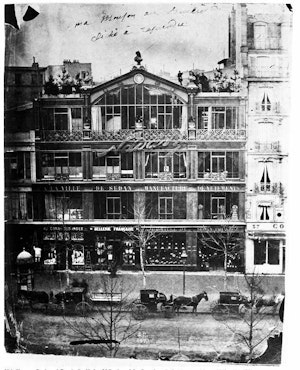
Photographer Nadar's studio where the first Impressionist exhibition was held, 1874.
Characteristics of Impressionist paintings
The works are characterized by the following points
💡Visible brush strokes
💡Outdoor production made possible by tube paints
💡Modernized Paris, an everyday object (motif) to be depicted
💡Depiction of light and color changes with time and movement
💡Novel painting angles
When Impressionism first emerged, it was not well received academically and sales were slow. Gradually, however, it became popular among the general bourgeois public, including financiers, department store owners, bankers, doctors, and singers. It was also particularly well received in the United States, a predominantly Protestant and Jewish country, thanks to its everyday subjects, such as nature and rural and urban life, which had little religious overtones.
Impressionism was Courbet and Manet s realism, as well as the Barbizon School and the Barbizon School, the group of avant-garde painters representing 19th-century France who led modern Western painting.
Monet's landscapes and Renoir's nudes are often introduced as representative Impressionist works, and it is an undeniable fact that "Impressionism" has established a firm position and popularity as the mainstream in the history of modern Western painting.
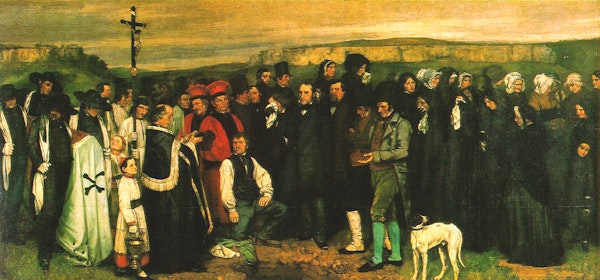
Gustave Courbet,Un enterrement à Ornans, 1850

Edouard Manet,Olympia, 1863
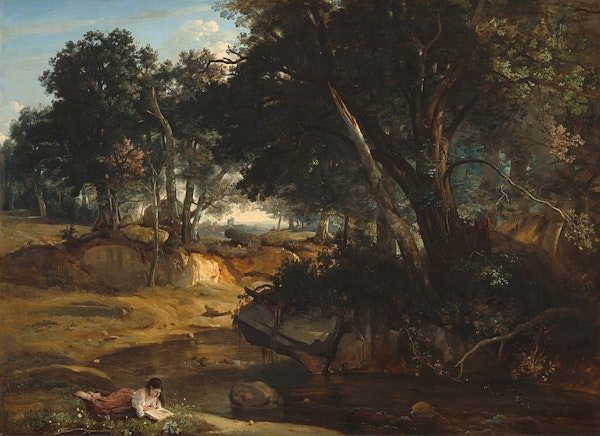
Camille Corot,a representative artist of the Barbizon School
The Pre-Impressionist World of Parisian Painting
It is important to note, however, that Impressionism was a heretical movement and a minor presence in French painting in the late 19th century. The mainstream of the time was the painters of the Royal Academy of Fine Arts in Paris. The condition to become a full-fledged painter of the period was to have one's work exhibited at the "Salon de Paris," an annual public exhibition held at the Academy.
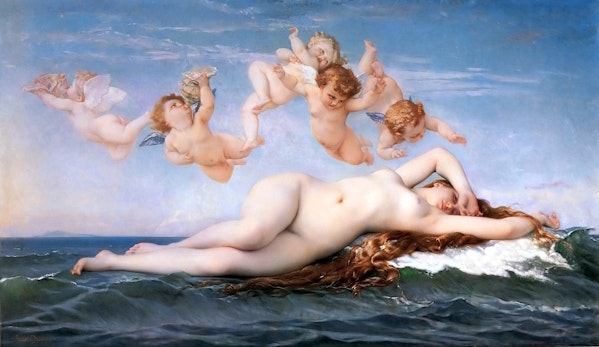
This work was highly acclaimed at the 1863 Salon. AlexandreCabanel|La Naissance de Vénus, 1863
However, this period also marked a gradual shift from " academism," which was centered on the Salon de Paris, to the " critical system," which was mainly supported by art dealers and critics. Outside the system of academism, avant-garde artists who sought new and free expression with the support of art dealers and critics were becoming active both socially and economically.
The main reason why free and original expression gained support from art dealers and critics was that modern values emphasizing individualism, which began with the French Revolution, were shared especially among the bourgeoisie.
Delacroix s Romanticism, Courbet and Courbet's realism were harbingers of this modern individualism, and Manet and Impressionism can be seen as extensions of this movement.
Impressionist painters were based in the Rue des Batignolles in Paris in the late 1860s and gathered at the Café Guerbois facing the Place de Clichy in that district. Painters, literary scholars, and critics, led by Manet and Degas, held discussions and became the mother body of Impressionism.

Eugène Delacroix (La Liberté guidant le peuple, 1830 )
The financial supporter of the Impressionists was the art dealer Paul Durand-Ruel. Although rejected by the academy, the works of the Impressionists gradually began to be accepted by the public.
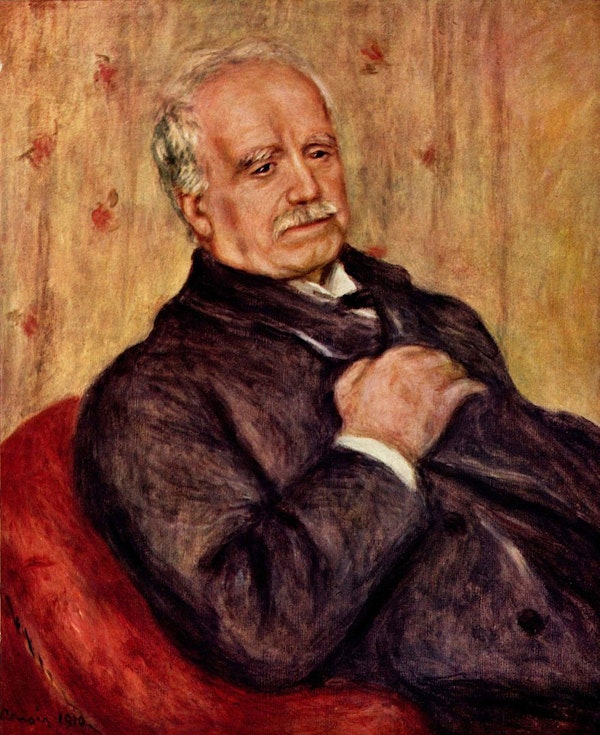
Portrait by Paul Durand-Ruel and Renoir
From the late 1860s, "independent" painters who shared artistic values with Manet, Degas, and others were denied entry to the Salon by the conservative Academy of Fine Arts, which organized the annual exhibition at the Salon de Paris. At the time, even if they passed the Salon de Paris jury and were able to exhibit, most impressionist painters were criticized by conservative critics and the public.
Therefore, in late 1873, Monet, Renoir, Camille Pissarro, Alfred Sisley, and others organized "a joint venture of painters, sculptors, printmakers, and other artists" to organize an exhibition independent of the Salon de Paris.
The exhibition opened on April 15, 1874, two weeks before the opening of the Salon de Paris, and lasted for a month, until May 15, when the first group exhibition organized by the joint venture was held at the photo studio of the photographer Nadar on Boulevard Capucine in Paris. This historic exhibition, later renamed the "First Impressionist Exhibition," was attended by 30 painters, with a total of 165 works on display.
As indicated by its official name, the exhibition was the first exhibition of the "Joint Venture Company of Painters, Sculptors, Printmakers, and Other Artists," a kind of cooperative of artists, and in reality there was a mixture of works by artists of different styles and painting styles, not just Impressionist-style works.
At the first Impressionist exhibition, Monet exhibited "Impression, Sunrise," a work that would make history for the group of artists participating in the exhibition. Impression, Sunrise, an oil painting by Monet in 1872, depicting a view of the port of Le Havre, was influenced by the subject matter and painting style of Camille Pissarro and Edouard Manet.

On April 25, shortly after the opening of the first exhibition, the art critic Louis Leroy published a review of the exhibition in Le Charivat, under the heading "Impressionist Exhibition," after the title of Monet's painting.
He wrote: "What in the world did these paintings depict? Look in the catalog."
It's called "Impression, Sunrise.
Impression! Of course I thought so. Of course it must be. I must have had a strong impression of it, so there must be plenty of impressions in it. ・・・・・・ How free and uninhibited his brushstrokes are! Even the wallpaper that he has just painted is far too finished compared to this seascape.
The review was scathing, but his scathing review led to the public's recognition of the terms "impressionism" and "impressionism. Although initially used in a derogatory sense, it was also used by the impressionist painters themselves.
Impressionists sometimes called themselves the "Independents," while others called them the "Batignolles," after the location of the Café Gerbois.
The Impressionist exhibition was held eight times in 1874, 1976, 1977, 1979, 1980, 1981, 1982, and 1986.
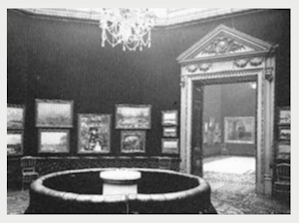
The Impressionists' Innovative Approach
The early Impressionists painted in a manner that went against the rules of painting established by the Royal Academy of Painting and Sculpture in France.
🎨 Capturing the landscape in the moment
At the heart of this approach is a subjective sensualism. He no longer sees reality as an immovable entity, but as an ever-changing phenomenon, and attempts to depict the visual world as it appears to an individual at a given moment in time. The basic principle of Impressionism is to capture the momentary vision of the brightness of light and the flicker of light reflected (or felt) in front of the viewer. Rather than depicting the landscape as it is in realistic form, the Impressionists sought to express the sensations brought about by the landscape.
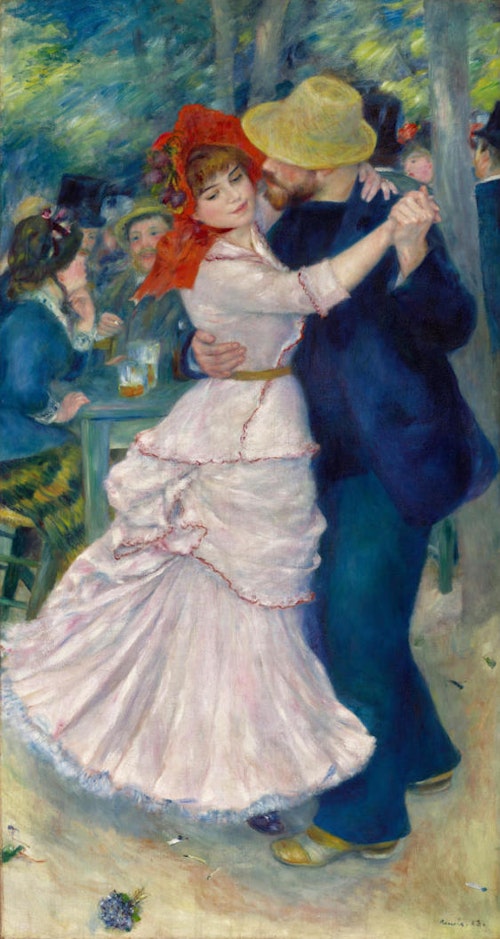
Dance at Bougival, 1883
The painting is a work of art. Free use of color and brushstrokes
The Impressionists, following the example of Romantic artists such as Turner and Delacroix, emphasized the free use of color and brushstrokes to compose their paintings, rather than lines and outlines.

EdgarDegas|L'Absinthe, 1876
🎨Outdoor production
The Impressionists also painted realistic scenes of modern life, so they mainly worked outdoors. The fact that the evolution of painting materials supported outdoor production cannot be overlooked. Until then, oil paints were usually stored in pig bladders. However, with the development of durable and portable paints in tubes, Impressionist painters began to use them, making it possible for the first time to paint in oil directly outside the studio.
Impressionist painters "discovered" that they could capture the instantaneous nature and transitions of sunlight by working outdoors or in an atrium. At the time, the Academy highly valued history, mythological and biblical paintings modeled on the art of ancient Rome, while other paintings were considered vulgar, and would have been considered quite avant-garde by the average artist of the time.

John SingerSargent|Claude Monet Painting by the Edge of a Wood
Emphasis on 🎨visual effects
Rather than focusing on the precise details, they emphasized the visual effect of the painting as a whole, arranging short, intermittent strokes of mixed and primary colors of paint, changing the vivid colors as if they were vibrating.
When Impressionism first emerged in France, the Macchia School in Italy and Winslow Homer in the U.S. were beginning to explore outdoor production in the same way overseas. The main difference, however, was that the Impressionists developed a new way of painting that differed from what had been taught by the previous academies.
Monet's Waterlilies series is typical in this respect.

ClaudeMonet|Haystacks, 1891
.jpg?w=500&h=632)
Water Lilies
What was innovative? -Summary of Impressionism
To sum up the main points discussed by the proponents of Impressionism, "It changed the way we look at painting. The art of light, expressed through immediacy, movement, bold poses and compositions, and vivid and varied colors, is the essence of Impressionism.
A new technique developed by the Impressionists, led by Monet, was the tactile division or color division technique.
In tactile division, the paints are not mixed together as much as possible, but instead are arranged in small touches of paint that are close to the primary colors. This maintains brightness and luminosity throughout the picture plane, increasing the sense of dynamism and allowing for subtle tonal changes and airy fluctuations to be expressed.
.jpg?w=600&h=445)
Pierre-Auguste Renoir|The Ball at Moulin de la Galette
This means that colors are mixed not on the palette as before, but on our retinas. This has the effect of visually mixing the colors between brushstrokes while avoiding the darkening of the colors by mixing the paints.
A typical, textbook Impressionist work would be that of Alfred Sisley. He consistently worked outdoors and maintained his Impressionist painting style.
Around 1900, Henri Matisse was the first to produce a painting by Camille Pissarro Matisse asked him, "Who is the typical Impressionist painter? Pissarro replied, " Sisley. Art historian Robert Rosenblum has described Sisley as "the Impressionist painting with the most generic features, impersonal and perfect for a textbook.
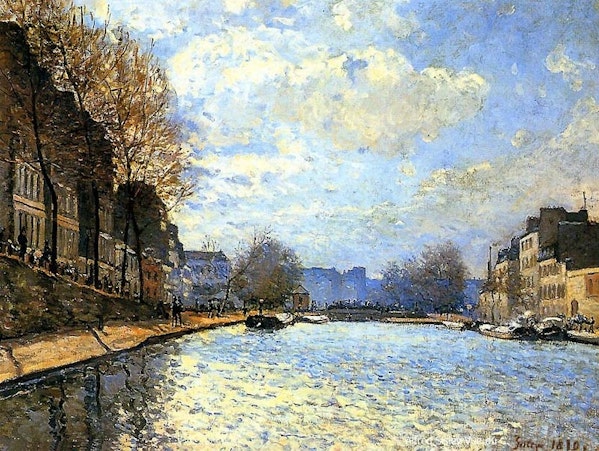
AlfredSisley|St. Martin Canal, 1870
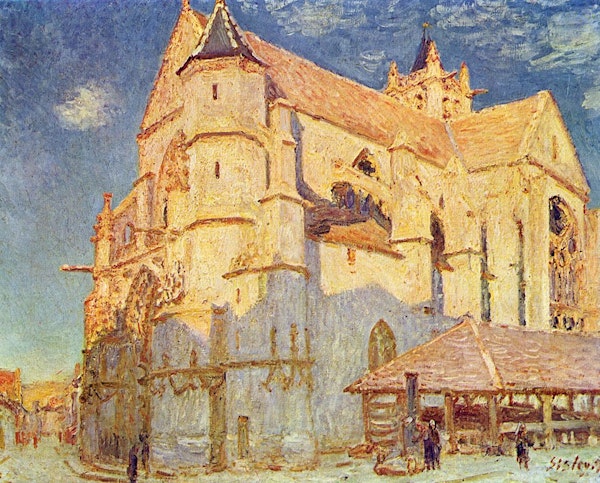
Church in Moret, 1889
Influence of Japanese Art
Many Impressionist painters, including Monet and Van Gogh, were influenced by ukiyoe, the art produced by the Japanese.
Utagawa Kuniyoshi and,
Impressionist Influences - Neo-Impressionism and Post-Impressionism
While the Impressionists placed brushstrokes based on sensibility, the Neo-Impressionists, who emerged later, attempted to divide colors theoretically and scientifically. As a result, the technique of "pointillism," in which dots are repeatedly dotted with a thin brush, was developed by Sura and Signac and Signac.
Pissarro called early impressionists such as Monet and Renoir "romantic impressionists, Seurat and Signac as "scientific impressionists.
They also skillfully used the complementary color effect pointed out in the color theory of the chemist Michel Eugène Chevreul at the time, in which the three primary colors (red, blue, and yellow) and the primary mixed colors (green, orange, and purple, created by mixing two of each of the three primary colors) are vividly enhanced by juxtaposing them with each other.
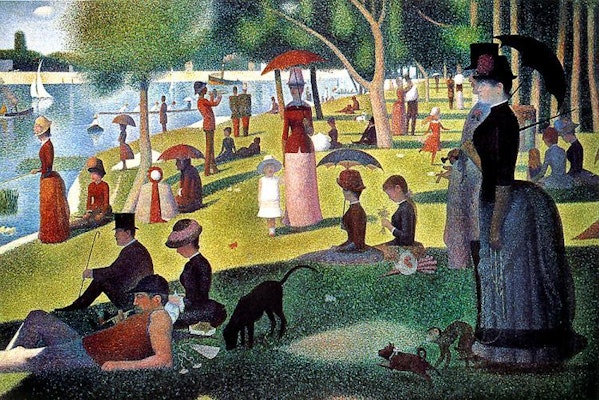
Un dimanche après-midi à l'Île de la Grande Jatte, 1884 -1886
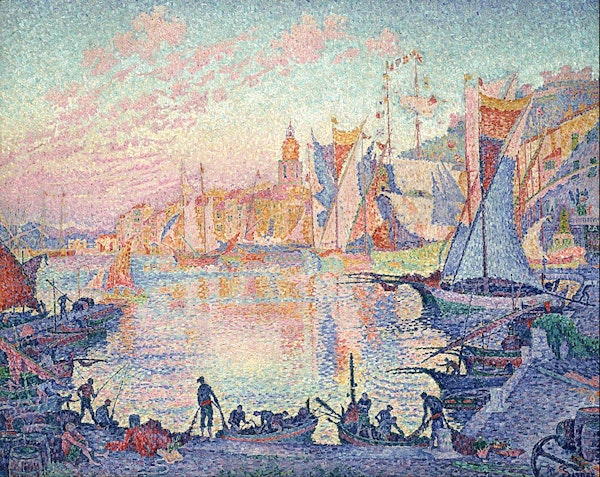
The Port of Saint-Tropez, 1901
Pointillism and Impressionism were groundbreaking techniques that overturned the realist expression of Western painting since the Renaissance and oriented a new style of painting based on the purity of vision.
The Impressionist painters did not work in unison under a unified theory until the third exhibition in 1877, after which a group led by Monet and Renoir, along with naturalistic painters such as Degas The group was divided into two groups: one led by Monet and Renoir, and the other by Degas, who added naturalistic painters to the group.
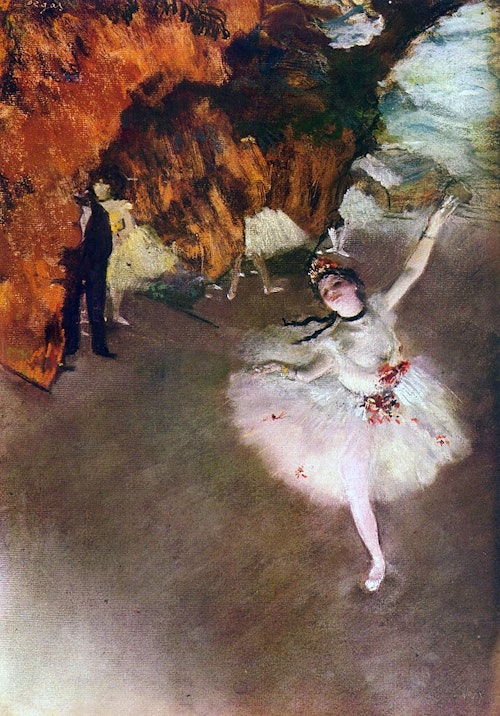
Edgar Degas,Ballet - L'étoile, 1878
The Neo-Impressionists such as Georges Seurat and Signac, who clearly used a pointillist technique that differed from the brush strokes of the Impressionists, as well as the Symbolists such as Redon and Gauguin, who were critical of the Impressionists, were represented at the 8th exhibition in 1986. Gauguin and others who were critical of Impressionism, effectively dismantling and ending the Impressionist movement.

Paul Gauguin (Femmes de Tahiti, 1891 )
Paul Cézanne is also an indispensable figure.
Cézanne was the first to arrive at the concept of "painting for painting's sake," which we recognize in painting today.

Paul Cezanne|Still life with a curtain
When considering the difference between Post-Impressionism and Early Impressionism, the last Impressionist exhibition and the year it was held, 1868, are important years that can be used as a benchmark. Historically, the 8th Impressionist Exhibition is considered to be the exhibition that marked the departure of the Early Impressionists and the rise of Neo-Impressionism and Symbolism (in general, Post-Impressionism).
Also read
10 Famous World Paintings|Learn about the most enduring masterpieces
10 Famous World Paintings|Dive deeper into modern art
Contemporary Art|5 Japanese Artists of World-Class
View the latest TRiCERA ART artworks
TRiCERA ART members enjoy a variety of privileges and preferences.
- Discounts, including members-only secret sales and coupons
- Create your own collection by registering your favorite artists
- Receive updates on popular artists, exhibitions, and events
- Receive a weekly newsletter with selected art
- Personal Assessment to find out what kind of art you like.
Please register as a member for free and receive the latest information.
Free Member Registration